Structure and Role of the Australian Parliamentary System
VerifiedAdded on 2023/06/10
|8
|1692
|330
AI Summary
This article provides an overview of the Australian Parliamentary System, including the Commonwealth parliament, the Governor-General, the Senate, and the House of Representatives. It also covers the structure and roles of the Western Australian Parliament, including the Legislative Assembly and the Legislative Council.
Contribute Materials
Your contribution can guide someone’s learning journey. Share your
documents today.
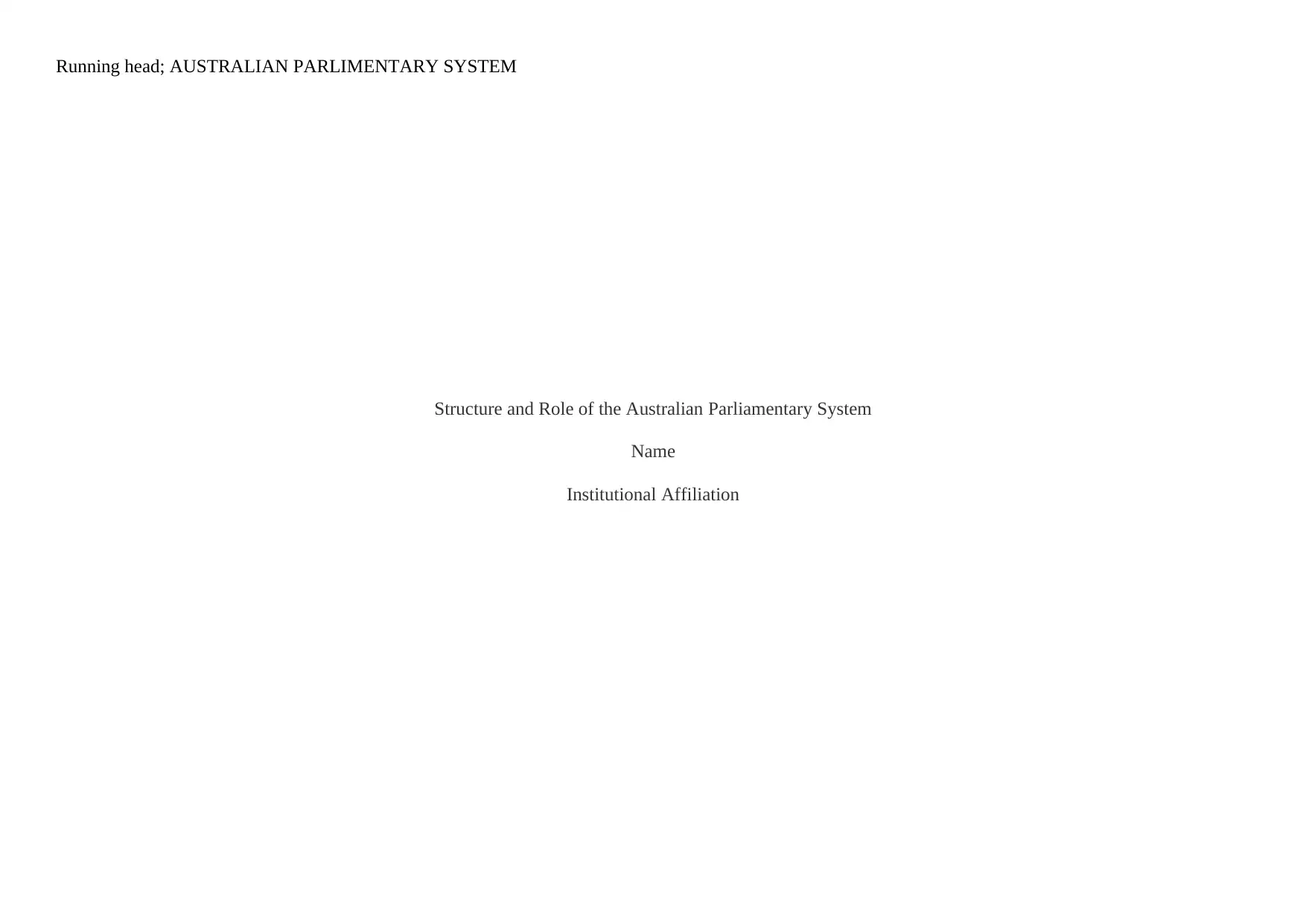
Running head; AUSTRALIAN PARLIMENTARY SYSTEM
Structure and Role of the Australian Parliamentary System
Name
Institutional Affiliation
Structure and Role of the Australian Parliamentary System
Name
Institutional Affiliation
Secure Best Marks with AI Grader
Need help grading? Try our AI Grader for instant feedback on your assignments.
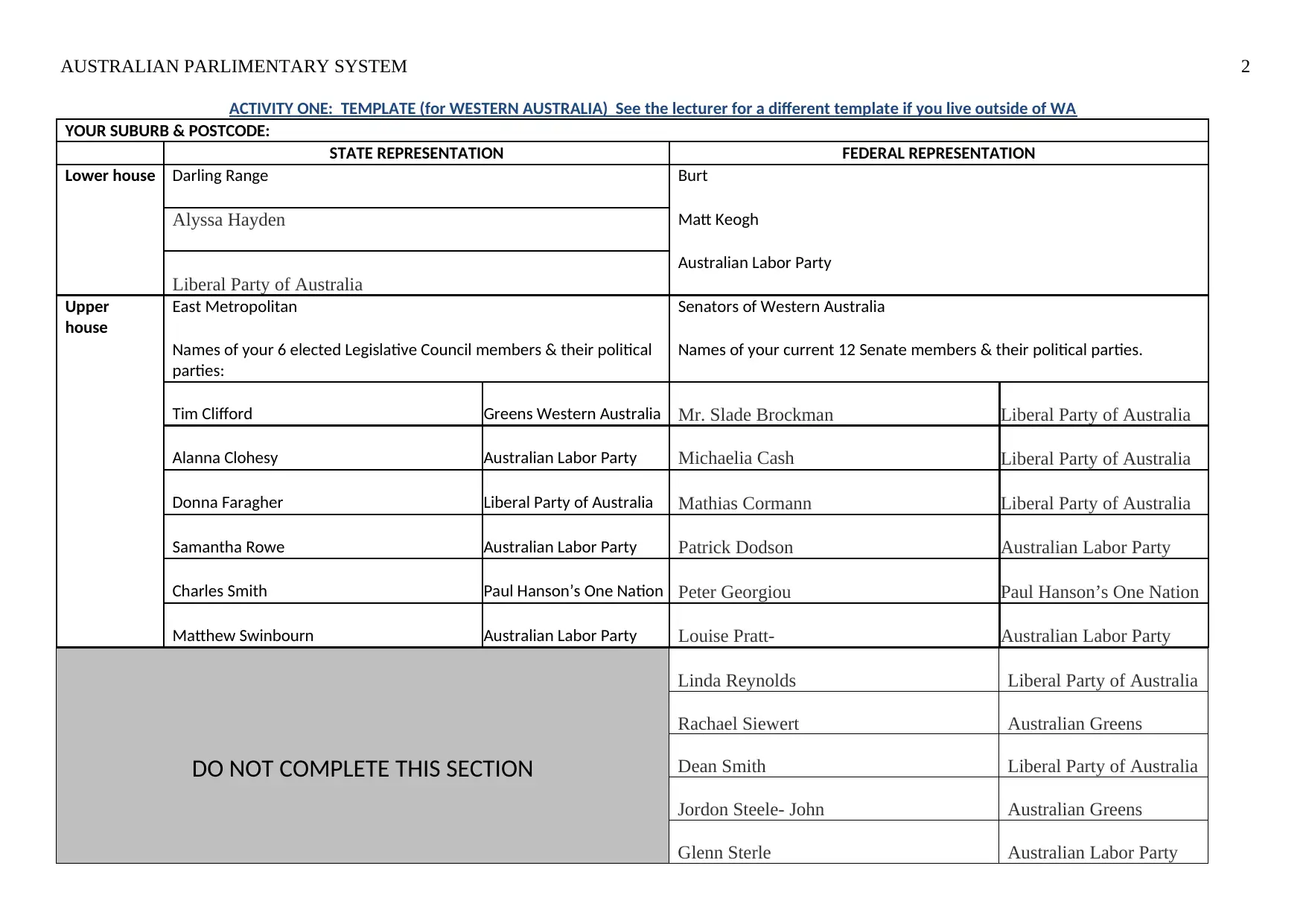
AUSTRALIAN PARLIMENTARY SYSTEM 2
ACTIVITY ONE: TEMPLATE (for WESTERN AUSTRALIA) See the lecturer for a different template if you live outside of WA
YOUR SUBURB & POSTCODE:
STATE REPRESENTATION FEDERAL REPRESENTATION
Lower house Darling Range Burt
Alyssa Hayden Matt Keogh
Liberal Party of Australia
Australian Labor Party
Upper
house
East Metropolitan Senators of Western Australia
Names of your 6 elected Legislative Council members & their political
parties:
Names of your current 12 Senate members & their political parties.
Tim Clifford Greens Western Australia Mr. Slade Brockman Liberal Party of Australia
Alanna Clohesy Australian Labor Party Michaelia Cash Liberal Party of Australia
Donna Faragher Liberal Party of Australia Mathias Cormann Liberal Party of Australia
Samantha Rowe Australian Labor Party Patrick Dodson Australian Labor Party
Charles Smith Paul Hanson’s One Nation Peter Georgiou Paul Hanson’s One Nation
Matthew Swinbourn Australian Labor Party Louise Pratt- Australian Labor Party
DO NOT COMPLETE THIS SECTION
Linda Reynolds Liberal Party of Australia
Rachael Siewert Australian Greens
Dean Smith Liberal Party of Australia
Jordon Steele- John Australian Greens
Glenn Sterle Australian Labor Party
ACTIVITY ONE: TEMPLATE (for WESTERN AUSTRALIA) See the lecturer for a different template if you live outside of WA
YOUR SUBURB & POSTCODE:
STATE REPRESENTATION FEDERAL REPRESENTATION
Lower house Darling Range Burt
Alyssa Hayden Matt Keogh
Liberal Party of Australia
Australian Labor Party
Upper
house
East Metropolitan Senators of Western Australia
Names of your 6 elected Legislative Council members & their political
parties:
Names of your current 12 Senate members & their political parties.
Tim Clifford Greens Western Australia Mr. Slade Brockman Liberal Party of Australia
Alanna Clohesy Australian Labor Party Michaelia Cash Liberal Party of Australia
Donna Faragher Liberal Party of Australia Mathias Cormann Liberal Party of Australia
Samantha Rowe Australian Labor Party Patrick Dodson Australian Labor Party
Charles Smith Paul Hanson’s One Nation Peter Georgiou Paul Hanson’s One Nation
Matthew Swinbourn Australian Labor Party Louise Pratt- Australian Labor Party
DO NOT COMPLETE THIS SECTION
Linda Reynolds Liberal Party of Australia
Rachael Siewert Australian Greens
Dean Smith Liberal Party of Australia
Jordon Steele- John Australian Greens
Glenn Sterle Australian Labor Party
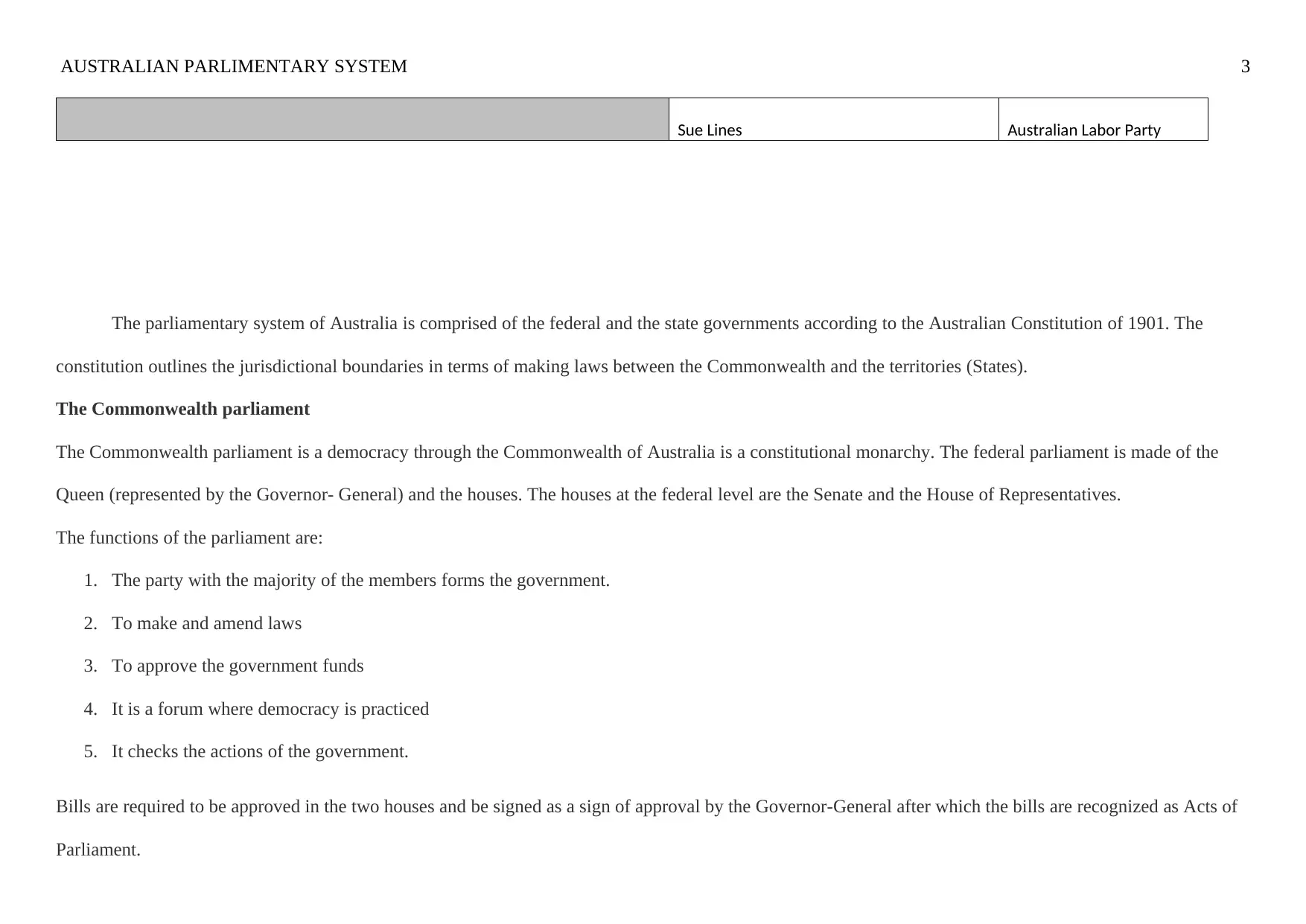
AUSTRALIAN PARLIMENTARY SYSTEM 3
Sue Lines Australian Labor Party
The parliamentary system of Australia is comprised of the federal and the state governments according to the Australian Constitution of 1901. The
constitution outlines the jurisdictional boundaries in terms of making laws between the Commonwealth and the territories (States).
The Commonwealth parliament
The Commonwealth parliament is a democracy through the Commonwealth of Australia is a constitutional monarchy. The federal parliament is made of the
Queen (represented by the Governor- General) and the houses. The houses at the federal level are the Senate and the House of Representatives.
The functions of the parliament are:
1. The party with the majority of the members forms the government.
2. To make and amend laws
3. To approve the government funds
4. It is a forum where democracy is practiced
5. It checks the actions of the government.
Bills are required to be approved in the two houses and be signed as a sign of approval by the Governor-General after which the bills are recognized as Acts of
Parliament.
Sue Lines Australian Labor Party
The parliamentary system of Australia is comprised of the federal and the state governments according to the Australian Constitution of 1901. The
constitution outlines the jurisdictional boundaries in terms of making laws between the Commonwealth and the territories (States).
The Commonwealth parliament
The Commonwealth parliament is a democracy through the Commonwealth of Australia is a constitutional monarchy. The federal parliament is made of the
Queen (represented by the Governor- General) and the houses. The houses at the federal level are the Senate and the House of Representatives.
The functions of the parliament are:
1. The party with the majority of the members forms the government.
2. To make and amend laws
3. To approve the government funds
4. It is a forum where democracy is practiced
5. It checks the actions of the government.
Bills are required to be approved in the two houses and be signed as a sign of approval by the Governor-General after which the bills are recognized as Acts of
Parliament.
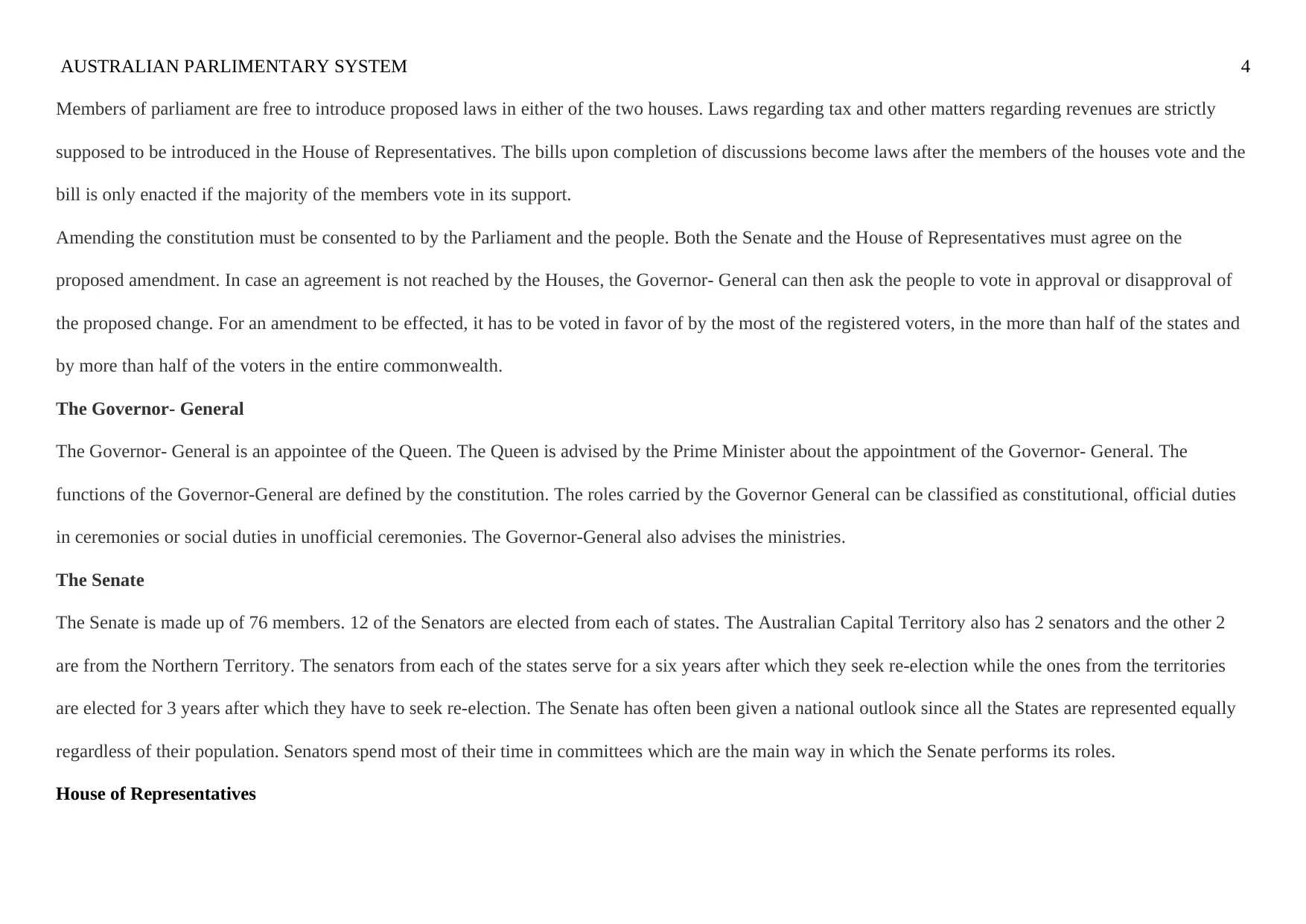
AUSTRALIAN PARLIMENTARY SYSTEM 4
Members of parliament are free to introduce proposed laws in either of the two houses. Laws regarding tax and other matters regarding revenues are strictly
supposed to be introduced in the House of Representatives. The bills upon completion of discussions become laws after the members of the houses vote and the
bill is only enacted if the majority of the members vote in its support.
Amending the constitution must be consented to by the Parliament and the people. Both the Senate and the House of Representatives must agree on the
proposed amendment. In case an agreement is not reached by the Houses, the Governor- General can then ask the people to vote in approval or disapproval of
the proposed change. For an amendment to be effected, it has to be voted in favor of by the most of the registered voters, in the more than half of the states and
by more than half of the voters in the entire commonwealth.
The Governor- General
The Governor- General is an appointee of the Queen. The Queen is advised by the Prime Minister about the appointment of the Governor- General. The
functions of the Governor-General are defined by the constitution. The roles carried by the Governor General can be classified as constitutional, official duties
in ceremonies or social duties in unofficial ceremonies. The Governor-General also advises the ministries.
The Senate
The Senate is made up of 76 members. 12 of the Senators are elected from each of states. The Australian Capital Territory also has 2 senators and the other 2
are from the Northern Territory. The senators from each of the states serve for a six years after which they seek re-election while the ones from the territories
are elected for 3 years after which they have to seek re-election. The Senate has often been given a national outlook since all the States are represented equally
regardless of their population. Senators spend most of their time in committees which are the main way in which the Senate performs its roles.
House of Representatives
Members of parliament are free to introduce proposed laws in either of the two houses. Laws regarding tax and other matters regarding revenues are strictly
supposed to be introduced in the House of Representatives. The bills upon completion of discussions become laws after the members of the houses vote and the
bill is only enacted if the majority of the members vote in its support.
Amending the constitution must be consented to by the Parliament and the people. Both the Senate and the House of Representatives must agree on the
proposed amendment. In case an agreement is not reached by the Houses, the Governor- General can then ask the people to vote in approval or disapproval of
the proposed change. For an amendment to be effected, it has to be voted in favor of by the most of the registered voters, in the more than half of the states and
by more than half of the voters in the entire commonwealth.
The Governor- General
The Governor- General is an appointee of the Queen. The Queen is advised by the Prime Minister about the appointment of the Governor- General. The
functions of the Governor-General are defined by the constitution. The roles carried by the Governor General can be classified as constitutional, official duties
in ceremonies or social duties in unofficial ceremonies. The Governor-General also advises the ministries.
The Senate
The Senate is made up of 76 members. 12 of the Senators are elected from each of states. The Australian Capital Territory also has 2 senators and the other 2
are from the Northern Territory. The senators from each of the states serve for a six years after which they seek re-election while the ones from the territories
are elected for 3 years after which they have to seek re-election. The Senate has often been given a national outlook since all the States are represented equally
regardless of their population. Senators spend most of their time in committees which are the main way in which the Senate performs its roles.
House of Representatives
Secure Best Marks with AI Grader
Need help grading? Try our AI Grader for instant feedback on your assignments.
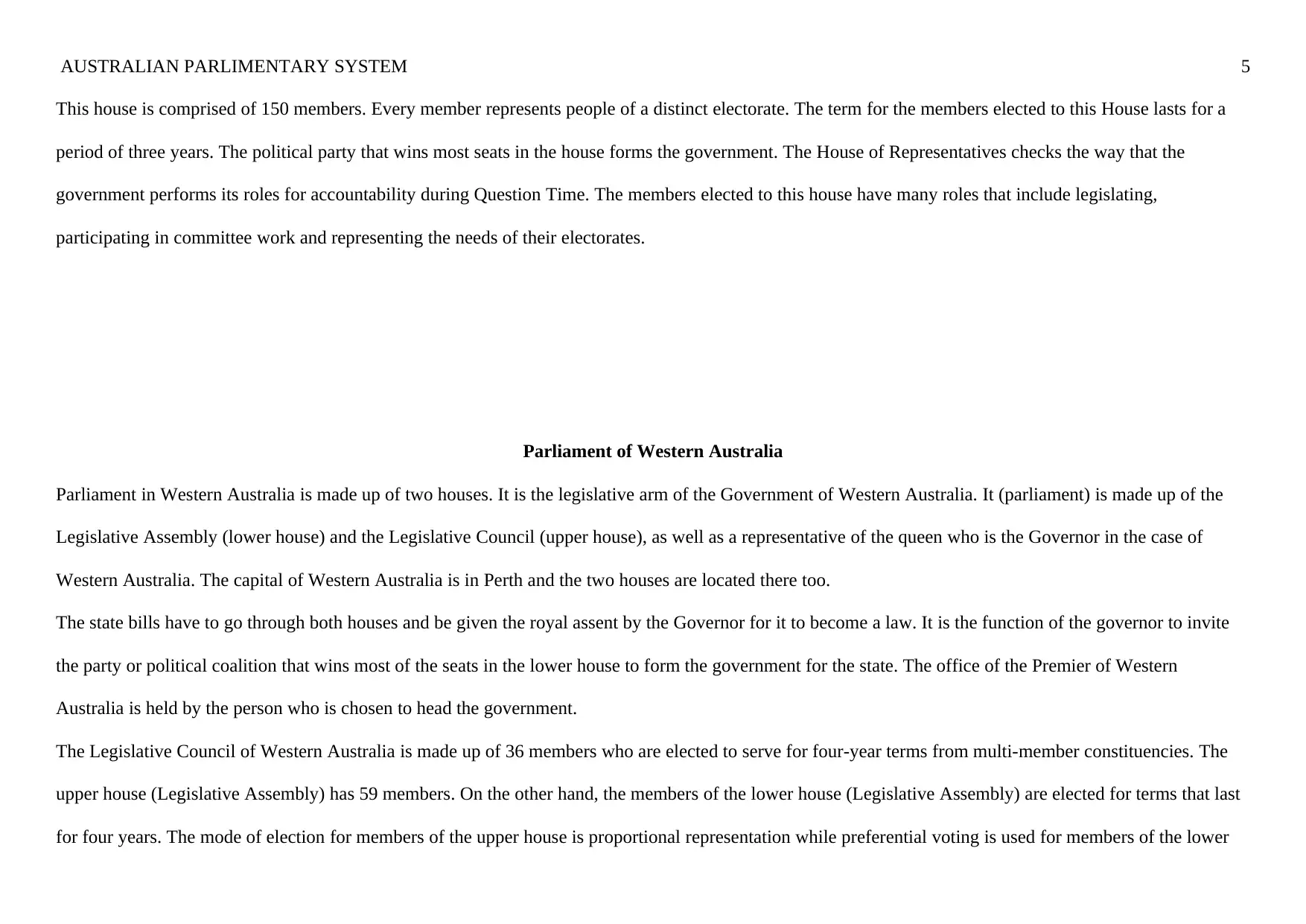
AUSTRALIAN PARLIMENTARY SYSTEM 5
This house is comprised of 150 members. Every member represents people of a distinct electorate. The term for the members elected to this House lasts for a
period of three years. The political party that wins most seats in the house forms the government. The House of Representatives checks the way that the
government performs its roles for accountability during Question Time. The members elected to this house have many roles that include legislating,
participating in committee work and representing the needs of their electorates.
Parliament of Western Australia
Parliament in Western Australia is made up of two houses. It is the legislative arm of the Government of Western Australia. It (parliament) is made up of the
Legislative Assembly (lower house) and the Legislative Council (upper house), as well as a representative of the queen who is the Governor in the case of
Western Australia. The capital of Western Australia is in Perth and the two houses are located there too.
The state bills have to go through both houses and be given the royal assent by the Governor for it to become a law. It is the function of the governor to invite
the party or political coalition that wins most of the seats in the lower house to form the government for the state. The office of the Premier of Western
Australia is held by the person who is chosen to head the government.
The Legislative Council of Western Australia is made up of 36 members who are elected to serve for four-year terms from multi-member constituencies. The
upper house (Legislative Assembly) has 59 members. On the other hand, the members of the lower house (Legislative Assembly) are elected for terms that last
for four years. The mode of election for members of the upper house is proportional representation while preferential voting is used for members of the lower
This house is comprised of 150 members. Every member represents people of a distinct electorate. The term for the members elected to this House lasts for a
period of three years. The political party that wins most seats in the house forms the government. The House of Representatives checks the way that the
government performs its roles for accountability during Question Time. The members elected to this house have many roles that include legislating,
participating in committee work and representing the needs of their electorates.
Parliament of Western Australia
Parliament in Western Australia is made up of two houses. It is the legislative arm of the Government of Western Australia. It (parliament) is made up of the
Legislative Assembly (lower house) and the Legislative Council (upper house), as well as a representative of the queen who is the Governor in the case of
Western Australia. The capital of Western Australia is in Perth and the two houses are located there too.
The state bills have to go through both houses and be given the royal assent by the Governor for it to become a law. It is the function of the governor to invite
the party or political coalition that wins most of the seats in the lower house to form the government for the state. The office of the Premier of Western
Australia is held by the person who is chosen to head the government.
The Legislative Council of Western Australia is made up of 36 members who are elected to serve for four-year terms from multi-member constituencies. The
upper house (Legislative Assembly) has 59 members. On the other hand, the members of the lower house (Legislative Assembly) are elected for terms that last
for four years. The mode of election for members of the upper house is proportional representation while preferential voting is used for members of the lower
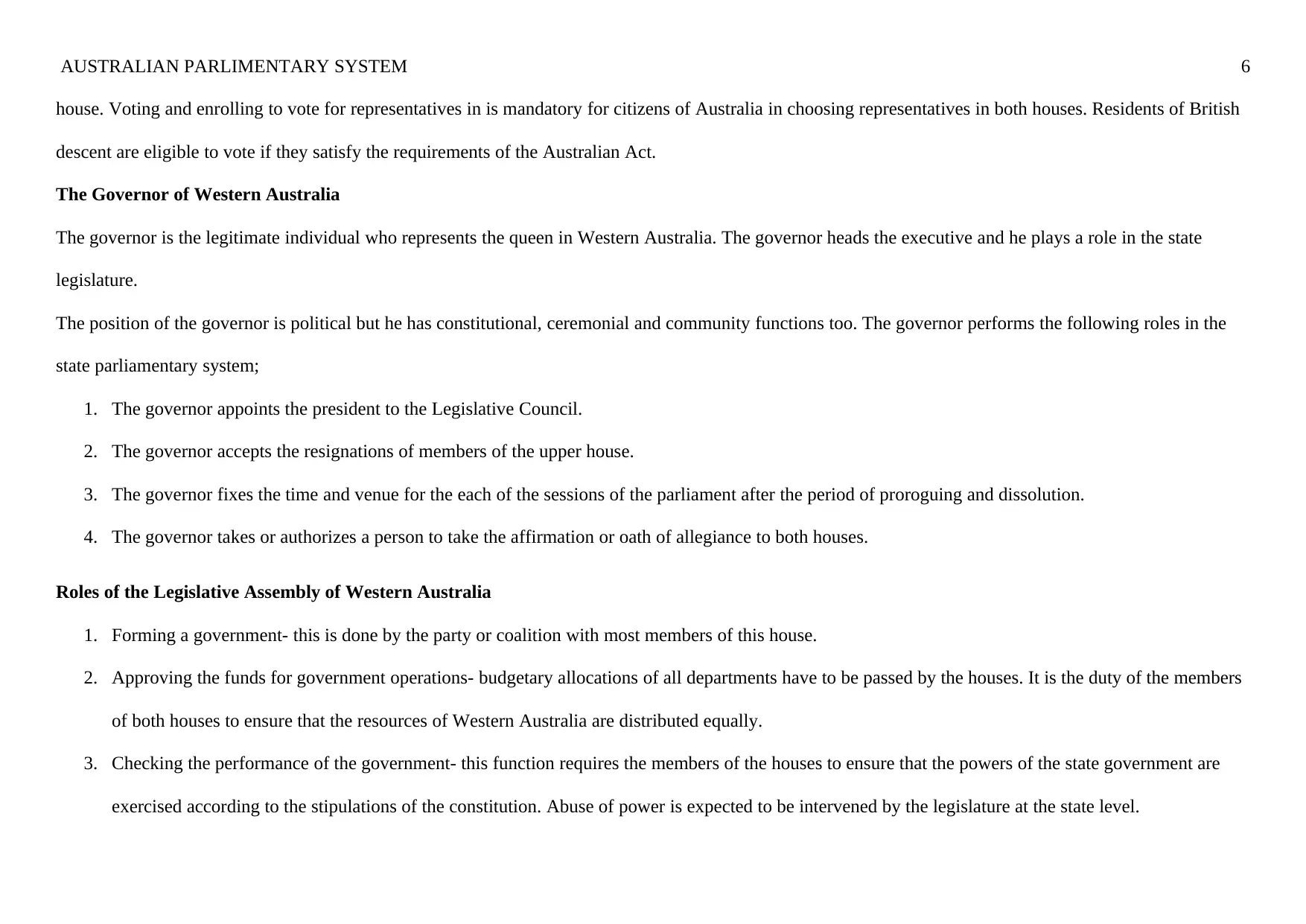
AUSTRALIAN PARLIMENTARY SYSTEM 6
house. Voting and enrolling to vote for representatives in is mandatory for citizens of Australia in choosing representatives in both houses. Residents of British
descent are eligible to vote if they satisfy the requirements of the Australian Act.
The Governor of Western Australia
The governor is the legitimate individual who represents the queen in Western Australia. The governor heads the executive and he plays a role in the state
legislature.
The position of the governor is political but he has constitutional, ceremonial and community functions too. The governor performs the following roles in the
state parliamentary system;
1. The governor appoints the president to the Legislative Council.
2. The governor accepts the resignations of members of the upper house.
3. The governor fixes the time and venue for the each of the sessions of the parliament after the period of proroguing and dissolution.
4. The governor takes or authorizes a person to take the affirmation or oath of allegiance to both houses.
Roles of the Legislative Assembly of Western Australia
1. Forming a government- this is done by the party or coalition with most members of this house.
2. Approving the funds for government operations- budgetary allocations of all departments have to be passed by the houses. It is the duty of the members
of both houses to ensure that the resources of Western Australia are distributed equally.
3. Checking the performance of the government- this function requires the members of the houses to ensure that the powers of the state government are
exercised according to the stipulations of the constitution. Abuse of power is expected to be intervened by the legislature at the state level.
house. Voting and enrolling to vote for representatives in is mandatory for citizens of Australia in choosing representatives in both houses. Residents of British
descent are eligible to vote if they satisfy the requirements of the Australian Act.
The Governor of Western Australia
The governor is the legitimate individual who represents the queen in Western Australia. The governor heads the executive and he plays a role in the state
legislature.
The position of the governor is political but he has constitutional, ceremonial and community functions too. The governor performs the following roles in the
state parliamentary system;
1. The governor appoints the president to the Legislative Council.
2. The governor accepts the resignations of members of the upper house.
3. The governor fixes the time and venue for the each of the sessions of the parliament after the period of proroguing and dissolution.
4. The governor takes or authorizes a person to take the affirmation or oath of allegiance to both houses.
Roles of the Legislative Assembly of Western Australia
1. Forming a government- this is done by the party or coalition with most members of this house.
2. Approving the funds for government operations- budgetary allocations of all departments have to be passed by the houses. It is the duty of the members
of both houses to ensure that the resources of Western Australia are distributed equally.
3. Checking the performance of the government- this function requires the members of the houses to ensure that the powers of the state government are
exercised according to the stipulations of the constitution. Abuse of power is expected to be intervened by the legislature at the state level.
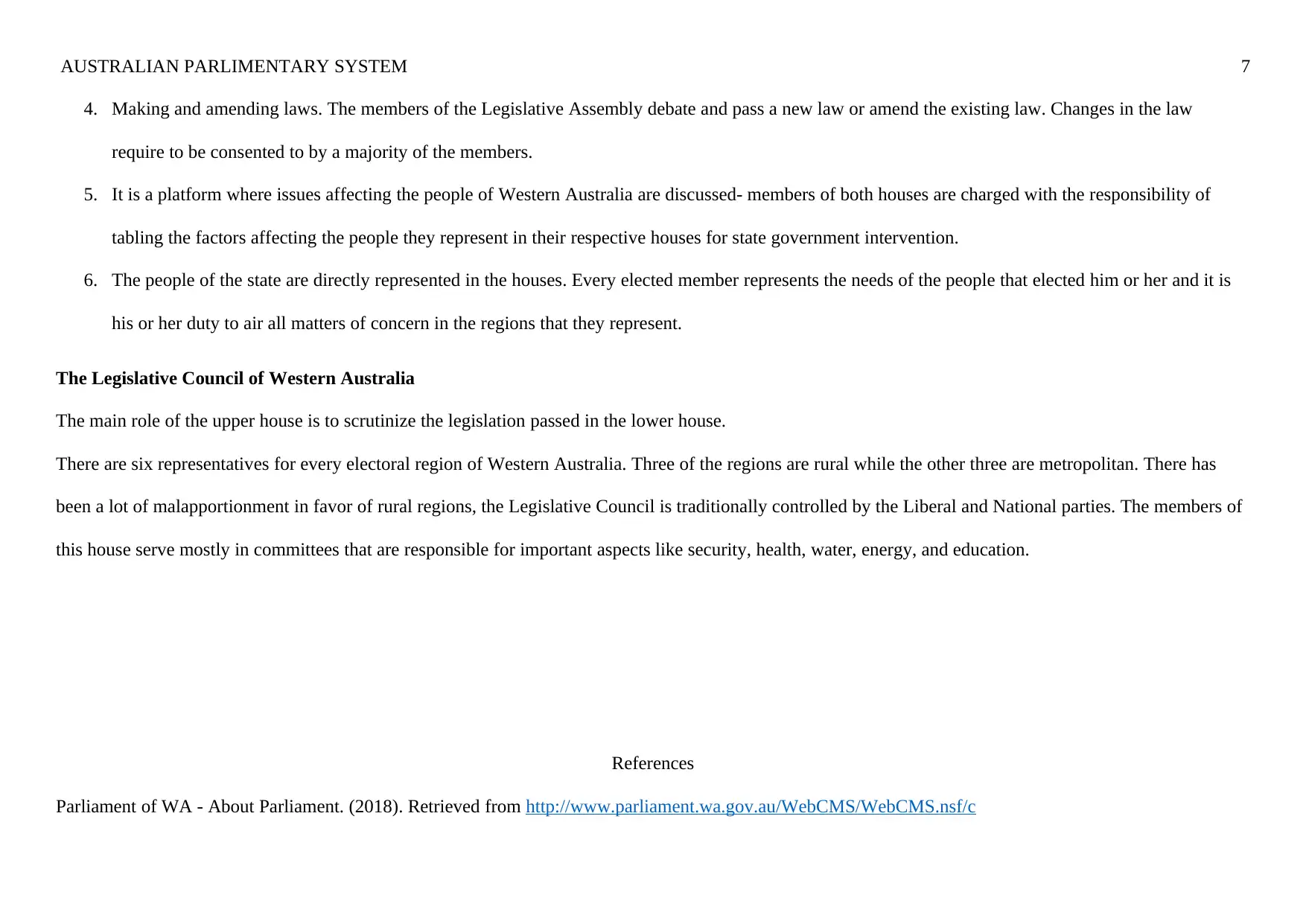
AUSTRALIAN PARLIMENTARY SYSTEM 7
4. Making and amending laws. The members of the Legislative Assembly debate and pass a new law or amend the existing law. Changes in the law
require to be consented to by a majority of the members.
5. It is a platform where issues affecting the people of Western Australia are discussed- members of both houses are charged with the responsibility of
tabling the factors affecting the people they represent in their respective houses for state government intervention.
6. The people of the state are directly represented in the houses. Every elected member represents the needs of the people that elected him or her and it is
his or her duty to air all matters of concern in the regions that they represent.
The Legislative Council of Western Australia
The main role of the upper house is to scrutinize the legislation passed in the lower house.
There are six representatives for every electoral region of Western Australia. Three of the regions are rural while the other three are metropolitan. There has
been a lot of malapportionment in favor of rural regions, the Legislative Council is traditionally controlled by the Liberal and National parties. The members of
this house serve mostly in committees that are responsible for important aspects like security, health, water, energy, and education.
References
Parliament of WA - About Parliament. (2018). Retrieved from http://www.parliament.wa.gov.au/WebCMS/WebCMS.nsf/c
4. Making and amending laws. The members of the Legislative Assembly debate and pass a new law or amend the existing law. Changes in the law
require to be consented to by a majority of the members.
5. It is a platform where issues affecting the people of Western Australia are discussed- members of both houses are charged with the responsibility of
tabling the factors affecting the people they represent in their respective houses for state government intervention.
6. The people of the state are directly represented in the houses. Every elected member represents the needs of the people that elected him or her and it is
his or her duty to air all matters of concern in the regions that they represent.
The Legislative Council of Western Australia
The main role of the upper house is to scrutinize the legislation passed in the lower house.
There are six representatives for every electoral region of Western Australia. Three of the regions are rural while the other three are metropolitan. There has
been a lot of malapportionment in favor of rural regions, the Legislative Council is traditionally controlled by the Liberal and National parties. The members of
this house serve mostly in committees that are responsible for important aspects like security, health, water, energy, and education.
References
Parliament of WA - About Parliament. (2018). Retrieved from http://www.parliament.wa.gov.au/WebCMS/WebCMS.nsf/c
Paraphrase This Document
Need a fresh take? Get an instant paraphrase of this document with our AI Paraphraser
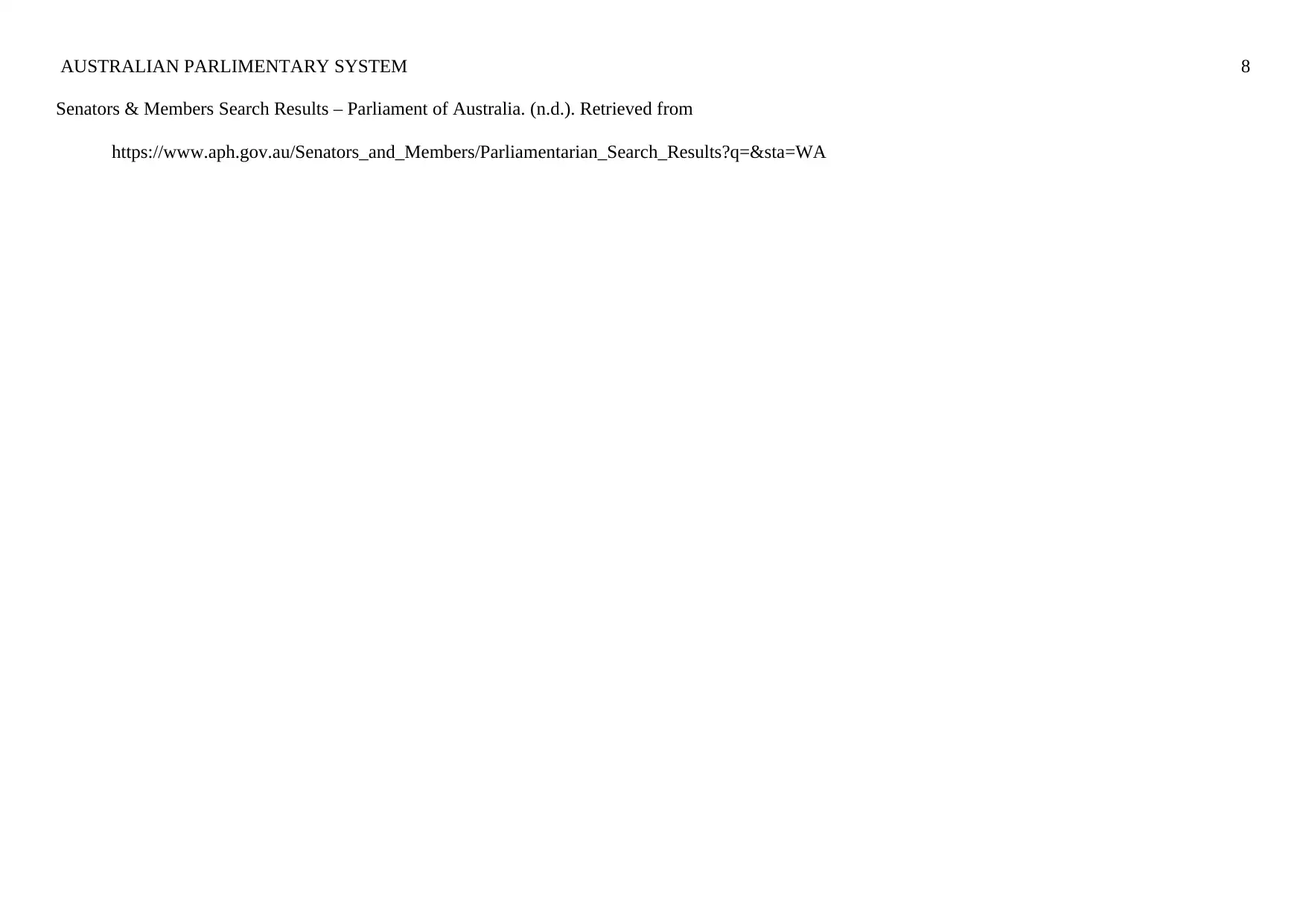
AUSTRALIAN PARLIMENTARY SYSTEM 8
Senators & Members Search Results – Parliament of Australia. (n.d.). Retrieved from
https://www.aph.gov.au/Senators_and_Members/Parliamentarian_Search_Results?q=&sta=WA
Senators & Members Search Results – Parliament of Australia. (n.d.). Retrieved from
https://www.aph.gov.au/Senators_and_Members/Parliamentarian_Search_Results?q=&sta=WA
1 out of 8
Related Documents
Your All-in-One AI-Powered Toolkit for Academic Success.
+13062052269
info@desklib.com
Available 24*7 on WhatsApp / Email
![[object Object]](/_next/static/media/star-bottom.7253800d.svg)
Unlock your academic potential
© 2024 | Zucol Services PVT LTD | All rights reserved.




